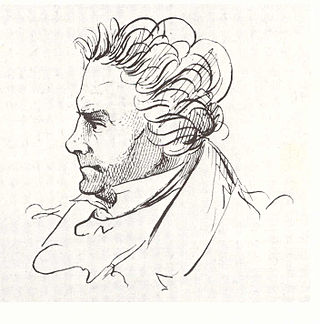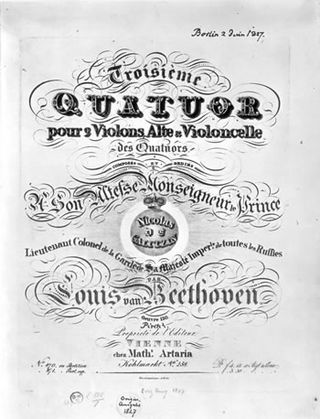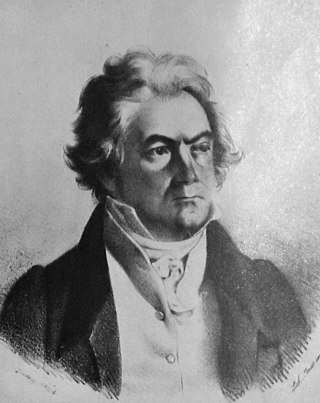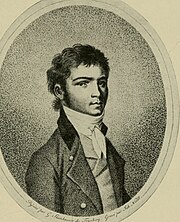
The String Quartet No. 16 in F major, Op. 135, by Ludwig van Beethoven was written in October 1826 and was the last major work he completed. Only the final movement of the Quartet Op. 130, written as a replacement for the Große Fuge, was composed later. The op. 135 quartet was premiered by the Schuppanzigh Quartet in March 1828, one year after Beethoven's death.
Robert Wilfred Levick Simpson was an English composer, as well as a long-serving BBC producer and broadcaster.

The String Quartet No. 1 in F major, Op. 18, No. 1, was written by Ludwig van Beethoven between 1798 and 1800, published in 1801, dedicated to the Bohemian aristocrat Joseph Franz von Lobkowitz. It is actually the second string quartet that Beethoven composed.

The String Quartet No. 2 in G major, Op. 18, No. 2, was written by Ludwig van Beethoven between 1798 and 1800 and published in 1801, dedicated to Joseph Franz von Lobkowitz.

The String Quartet No. 3 in D major, Op. 18, No. 3, was written by Ludwig van Beethoven between 1798 and 1800 and published in 1801, dedicated to Joseph Franz von Lobkowitz. Although it is numbered third, it was the first quartet Beethoven composed.

The String Quartet No. 6 in B-flat major, Op. 18, No. 6, was written between 1798 and 1800 by Ludwig van Beethoven and published in 1801, and dedicated to Joseph Franz von Lobkowitz.

The String Quartet No. 13 in B♭ major, Op. 130, by Ludwig van Beethoven was completed in November 1826. The number traditionally assigned to it is based on the order of its publication; it is actually Beethoven's 14th quartet in order of composition. It was premiered in March 1826 by the Schuppanzigh Quartet and dedicated to Nikolai Galitzin on its publication in 1827.

Ludwig van Beethoven's String Quartet No. 11 in F minor, Op. 95, from 1810, was his last before his late string quartets. It is commonly referred to as the "Serioso," stemming from his title "Quartett[o] Serioso" at the beginning and the tempo designation for the third movement.

The Symphony No. 2 in D major, Op. 36, is a symphony in four movements written by Ludwig van Beethoven between 1801 and 1802. The work is dedicated to Karl Alois, Prince Lichnowsky.

Ludwig van Beethoven completed his String Quartet No. 12 in E♭ major, Op. 127, in 1825. It is the first of his late quartets. Commissioned by Nicolas Galitzin over a year earlier, the work was not ready when it was scheduled to premiere. When it finally premiered by the Schuppanzigh Quartet, it was not well received. Only with subsequent performances by the Bohm Quartet and the Mayseder Quartet did it begin to gain public appreciation.

The String Quartet No. 15 in A minor, Op. 132, by Ludwig van Beethoven, was written in 1825, given its public premiere on November 6 of that year by the Schuppanzigh Quartet and was dedicated to Count Nikolai Galitzin, as were Opp. 127 and 130. The number traditionally assigned to it is based on the order of its publication; it is actually the thirteenth quartet in order of composition.

The String Quartet No. 9 in C major, Op. 59, No. 3, was written by Ludwig van Beethoven and published in 1808. This work is the third of three of his "Razumovsky" cycle of string quartets, and is a product of his "middle" period. It consists of four movements:

The Grosse Fuge, Op. 133, is a single-movement composition for string quartet by Ludwig van Beethoven. An immense double fugue, it was universally condemned by contemporary music critics. A reviewer writing for the Allgemeine musikalische Zeitung in 1826 described the fugue as "incomprehensible, like Chinese" and "a confusion of Babel". However, critical opinion of the work has risen steadily since the early 20th century and it is now considered among Beethoven's greatest achievements. Igor Stravinsky described it as "an absolutely contemporary piece of music that will be contemporary forever".

The String Quartet No. 13 in A minor, D 804, Op. 29, was written by Franz Schubert between February and March 1824. It dates roughly to the same time as his monumental Death and the Maiden Quartet, emerging around three years after his previous attempt to write for the string quartet genre, the Quartettsatz, D 703, that he never finished.

The Octet in F major, D. 803 was composed by Franz Schubert in March 1824. It was commissioned by the renowned clarinetist Ferdinand Troyer and came from the same period as two of Schubert's other major chamber works, the 'Rosamunde' and 'Death and the Maiden' string quartets.

Ludwig van Beethoven's String Quartet No. 10 in E-flat major, Op. 74, was written in 1809 and is nicknamed the "Harp" quartet.
The String Quartet No. 2 in A minor, Op. 13, was composed by Felix Mendelssohn in 1827. Written when he was 18 years old, it was, despite its official number, Mendelssohn's first mature string quartet. One of Mendelssohn's most passionate works, the A minor Quartet is one of the earliest and most significant examples of cyclic form in music.
Wolfgang Amadeus Mozart's String Quartet No. 18 in A major, K. 464, the fifth of the Quartets dedicated to Haydn, was completed in 1785. Mozart's autograph catalogue states as the date of composition "1785. / the 10th January". It is in four movements:
- Allegro
- Menuetto and Trio
- Andante, D major
- Allegro non troppo
Johannes Brahms' String Quartet No. 1 in C minor and String Quartet No. 2 in A minor were completed in Tutzing, Bavaria, during the summer of 1873, and published together that autumn as Op. 51. They are dedicated to his friend Theodor Billroth. He only published one other string quartet, No. 3 in B-flat Major, in 1875.

The three String Trios, Op. 9 were composed by Ludwig van Beethoven in 1797–98. He published them in Vienna in 1799, with a dedication to his patron Count Johann Georg von Browne (1767–1827). They were first performed by the violinist Ignaz Schuppanzigh with two colleagues from his string quartet. According to the violinist and conductor Angus Watson, these were probably Franz Weiss on viola and either Nikolaus Kraft or his father Anton on cello. Each of the trios consists of four movements:











